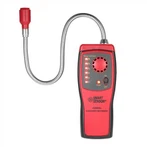How to systematically calibrate a coating thickness gauge
How to systematically calibrate a coating thickness gauge? The coating thickness gauge can non-destructively measure the thickness of non-magnetic coatings (such as aluminum, chromium, copper, enamel, rubber, paint, etc.) The thickness of a non-conductive coating (eg, enamel, rubber, paint, plastic, etc.) on a metal substrate (eg, copper, aluminum, zinc, tin, etc.).
The coating thickness gauge has the characteristics of small measurement error, high reliability, good stability, and easy operation. It is an indispensable testing instrument for controlling and ensuring product quality. It is widely used in manufacturing, metal processing, chemical industry, Commodity inspection and other testing fields. So, how to systematically calibrate the coating thickness gauge? Zhuhai Tianchuang Instrument Co., Ltd. will give you a brief introduction:
The method and type of calibration This is a problem often encountered by new users. System calibration, zero point calibration, and two-point calibration have actually been written in the manual, and users only need to read it carefully. It should be noted that when calibrating the iron base, it is necessary to measure several times to prevent wrong operation; the samples for system calibration should be carried out in order from small to large. If individual standard pieces are lost, you can find samples with similar values to replace them.






